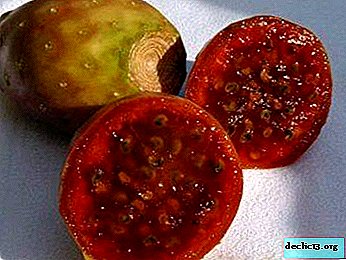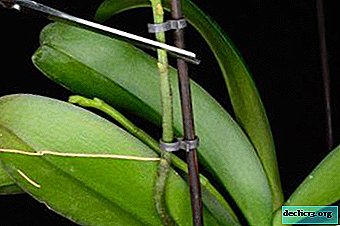Practical recommendations for growing Super Dorothy climbing roses. Photo and description of the variety

If you want to get a climbing rose on your garden plot, then Super Dorothy (Super Dorothy) is a great option.
But first, it is important to familiarize yourself with the basic requirements of this beauty.
Before landing, you should pay attention to the place prepared for it, the soil, the supporting structure.
Detailed description
Super Dorothy Rose - one of the best climbing roses. The shape of the flower is uncharacteristic for roses, closer to the end of flowering, the petals are wrapped out, adding volume. Thus, the shape is more like pompons. Given that at the same time about 40-50 inflorescences bloom at once, voluminous brushes add fluffiness to the bush, as a result of green foliage it is practically invisible.
The diameter of one inflorescence of a rose is on average 5 cm. Petals have a terry texture, the color is bright pink, even raspberry. The reverse side of the petals is pale with a white spot in the center.The foliage is small, shiny, resistant to fungal diseases. The bush grows from 2 to 3 meters high, 1.5 meters wide. The shoots are flexible, with virtually no spikes. Rose emits a delicate aroma of vanilla.
We offer you to watch a video about the rose of Super Dorothy:
Photo
Next, you can see how the roses growing in the country look in the photo.



History of occurrence
Yet back in 1901, the Dorothy Perkins variety was bred in the USA, which subsequently became the progenitor of the climbing rose Super Dorothy. It was the latter that was bred by the German breeding nursery Hetzel in 1986. Super Dorothy is far superior to its predecessor. German breeders increased frost resistance, resistance to fungal diseases, the possibility of a second wave of flowering.
Distinctive features
The Super Dorothy variety has a number of advantages that distinguish it from other subspecies:
- disease resistance;
- lack of prickly spikes;
- high winter hardiness;
- flexibility, whips freely take the form of a support;
- inflorescences do not lose their neat appearance under the influence of rainfall.
Bloom
The bud blooming time is relatively late. This period falls in June and lasts until the first frost. The buds themselves are quite bright, but with prolonged exposure to the sun, the color gradually fades. Flowers can be seen back in October, subject to warm autumn.
Care before and after
 The Super Dorothy variety in care is no different from other species.
The Super Dorothy variety in care is no different from other species.
- Therefore, it is required:
- regular loosening of the soil;
- trimming dry lashes;
- weed removal.
- With the advent of spring, fertilizing with nitrogen-based fertilizers, and with the advent of the first buds, nitrogen cannot be used. Together it is possible to use potassium phosphorus fertilizers.
- After flowering, the climbing rose must be correctly cut.
- cut off faded buds, grassy shoots;
- pinch growing shoots over 3-4 buds to stimulate shoots.
What to do if it does not bloom?
- Lack of flowering may be due to improper placement of plants. It is not recommended to plant rose bushes closer than 2 meters apart.
- When overfeeding the flower, you can also not wait for the buds. Nitrogen stimulates growth, and when used abundantly, the plant gains green mass at the expense of flowering.
- Unsuitable soil. In this case, it is advisable in the fall, when it will become cool outside, make a transplant and choose a more suitable place, with soil enriched with minerals.
Step-by-step care instructions
Super Dorothy roses don't need special farming events. Basic requirements are standard.
Seat selection
- For a climbing plant, areas filled with the sun are not bad, but in the conditions of diffused light it also continues to fully develop. Inflorescences for a long time delight with their beauty, so the petals have the ability to burn out.
- Good for the plant are nooks, devoid of drafts and wind.
- Climbing roses need a garter, so you should provide support for flowers.
What should be the soil?
 Optimal Ground for Super Dorothy:
Optimal Ground for Super Dorothy:
- light
- fertile;
- drained;
- moderately hydrated.
Be sure to dilute the soil:
- peat;
- organic fertilizers;
- turf land;
- sand;
- ash.
Do not neglect drainage. It is usually made of chipped brick or gravel.
On the site it would not hurt to know the groundwater level. The permissible depth should not be less than 1 meter.
Garden soil should have a pH of 5.5-6.5.
Landing
Super Dorothy roses are usually planted in April-May.:
- The roots of the cuttings are pre-soaked in a solution of the root growth stimulator for about 5 hours, during which they are completely saturated with moisture.
- Prepare a pit measuring 40x40 cm and a depth of 50 cm.
- All the necessary components are poured to the bottom, as well as 300 grams of wood ash to reduce the acidity of the soil.
- In the center of the fossa, a stalk is set, sprinkled with earth and rammed tightly.
- After it is worth pouring water.
Bushes of climbing roses are placed at a distance so that they do not interfere with each other.
Temperature
Climbing rose Super Dorothy is a frost-resistant variety and belongs to the 5th climatic zone (St. Petersburg and the region, Moscow, Moscow region, the middle zone of Russia). Given the plant is able to withstand a minimum temperature of -29 ° C. The maximum parameters in the summer are + 35-40 ° С. The optimum temperature range is considered to be + 18-22 ° С.
Watering
 Super Dorothy must be watered while caring for the rose. In this case, the earth should not completely dry out or be constantly wet.
Super Dorothy must be watered while caring for the rose. In this case, the earth should not completely dry out or be constantly wet.
- Watering the plant is enough once every 7 days. For these purposes, you need warm, standing water with a volume of 15-20 liters under the bush.
- The irrigation procedure is recommended to be performed in the evening.
- With the onset of autumn, water procedures are stopped.
Pruning
The Super Dorothy rose is cut three times during the season.
- Spring, April-May. Preventative procedure. Dry, damaged, frozen whips are cut. Shorten last year's shoots.
- Summer, June-August. To stimulate flowering. Eliminate dried buds. Cut unnecessary young sprouts. Perform a pinch.
- Autumn, September-October. Sanitary. Unripe shoots, leaves are removed.
- Spring april. Perform 1 time in 5 years. Anti-aging. Woody old shoots should be cut, leaving up to five young, strong lashes.
Removing dry buds stimulates future flowering.
How to tie plants?
Long thin lashes Super Dorothy should certainly be tied to a support that has been pre-installed. Supports may be in the form of:
- arches;
- grids;
- conical design.
The use of metal wire is not recommended as a tie, as it damages the shoots. It is better to take a nylon cord or other soft material that does not harm the integrity of the plant.
Transfer
 An adult plant needs a transplant if the previous place did not fit for any reason. It is advised to perform it in early autumn, until the roots begin to adapt to the cold, or in early spring before the appearance of buds. For a rose transplant stands:
An adult plant needs a transplant if the previous place did not fit for any reason. It is advised to perform it in early autumn, until the roots begin to adapt to the cold, or in early spring before the appearance of buds. For a rose transplant stands:
- gently dig out a recess and gently get a flower;
- inspect the root system and leave healthy, dense shoots, remove excess ones with secateurs;
- when planting a plant, it is necessary to spread the roots in a new pit so that they do not stick up;
- then cover with earth and water.
Preparation for winter
At the first signs of cooling, organizational work is carried out to prepare for wintering.- Super Dorothy bush at the base spud with peat or earth 30 cm high.
- The scourges are removed from the support, tied and gently bent onto a substrate of boards or needles.
- On top build a mini greenhouse on the frame. Prior to the onset of extreme cold, leave uncovered ventilation areas.
- When the temperature drops to the limit of -10 ° C, the rose is finally wrapped. And it’s worth revealing the beauty when the air warms up to + 10 ° С.
Step-by-step instruction: how to propagate?
This variety of climbing roses is planted with cuttings or layering.
- Cuttings.
- For this, cuttings are prepared from the middle of a faded whip, 15 cm long.
- Such blanks are immersed in a moist substrate and covered with a film on top.
- The resulting plant can be planted in open ground only for the third season.
- Layering.
- The lower lash is bent, fixed with brackets and instilled with earth.
- After a year, the process is separated from the mother plant.
Some gardeners, inexperience, are trying to propagate Super Dorothy by dividing the bush. However, this is only realistic if the plant is not grafted.
Diseases and Pests
 Super Dorothy climbing roses may be affected by powdery mildew during the summer season. Therefore, in order to prevent, in the early spring, it is recommended to treat the bush with a copper-containing preparation, for example, copper sulfate. And then spray the flower with a chemical solution as necessary.
Super Dorothy climbing roses may be affected by powdery mildew during the summer season. Therefore, in order to prevent, in the early spring, it is recommended to treat the bush with a copper-containing preparation, for example, copper sulfate. And then spray the flower with a chemical solution as necessary.- The main enemy of this species is green aphid. Drugs help get rid of it:
- "Aktara";
- "Commander";
- "Alatar."
More gentle biological product "Fitoverm". And for the purpose of prevention, you can use folk remedies:
- decoctions of onion peel;
- milk with iodine.
Wicker Super Dorothy rose is one of the five super roses bred by German breeding farm Hetzel. Its stable flowering, frost resistance, and the ability to not fade for a long time in a vase are noted. The flower is beautiful and amazing, but since it was created more than 30 years ago, it can be found under other names HELdoro, Superb Dorothy.

 Super Dorothy climbing roses may be affected by powdery mildew during the summer season. Therefore, in order to prevent, in the early spring, it is recommended to treat the bush with a copper-containing preparation, for example, copper sulfate. And then spray the flower with a chemical solution as necessary.
Super Dorothy climbing roses may be affected by powdery mildew during the summer season. Therefore, in order to prevent, in the early spring, it is recommended to treat the bush with a copper-containing preparation, for example, copper sulfate. And then spray the flower with a chemical solution as necessary.















